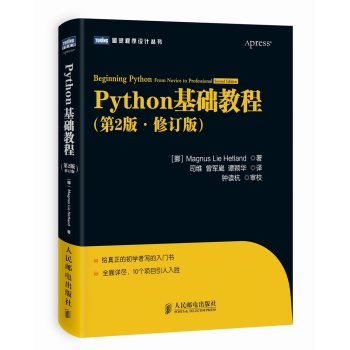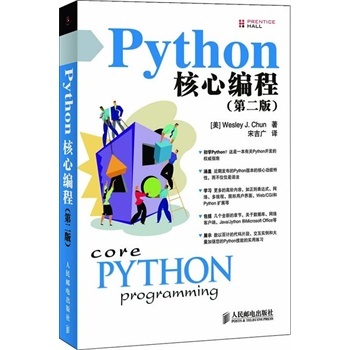简明Python3教程 15.异常
2012-12-10 11:10
253 查看
简介
当程序发生意外情况时则产生异常。
例如你需要读一个文件而这个文件并不存在会咋样?又或者是程序运行时你把它误删除了呢?
上述情形通过异常进行处理。
类似的,如果你的程序存在一些非法语句会发生什么呢?这时python会举手告诉你存在一个错误。
错误
考虑一个简单的print函数调用。如果我们把print错拼成Print(注意大小写),这时python将引发一个语法错误。
>>> Print('Hello World')
Traceback (most recent call last):
File "<pyshell#0>", line 1, in <module>
Print('Hello World')
NameError: name 'Print' is not defined
>>> print('Hello World')
Hello World
我们看到一个NameError被引发并且发生错误的位置也被打印出来。这就是一个错误处理器(error handler)为这个错误所进行的处理。
异常
我们尝试从用户读取输入,看看当键入ctrl-d(注:windows用户输入ctrl-z)时会发生什么。
>>> s = input('Enter something --> ')
Enter something -->
Traceback (most recent call last):
File "<pyshell#2>", line 1, in <module>
s = input('Enter something --> ')
EOFError: EOF when reading a line
(注:也许你看到的信息会所有不同,但只要引发了EOFError即可)
可以看到python引发了一个被称作EOFError的异常,一般这意味着它遇到了一个非期望的文件尾(end of file)符号(注:windows下为ctrl-z)
处理异常
利用try...except语句使得我们可以处理异常。通常我们将语句放入try块而将错误处理放到except块中。
#!/usr/bin/python
# Filename: try_except.py
try:
text = input('Enter something --> ')
except EOFError:
print('Why did you do an EOF on me?')
except KeyboardInterrupt:
print('You cancelled the operation.')
else:
print('You entered {0}'.format(text))
输出:
$ python try_except.py
Enter something --> # Press ctrl-d
Why did you do an EOF on me?
$ python try_except.py
Enter something --> # Press ctrl-c
You cancelled the operation.
$ python try_except.py
Enter something --> no exceptions
You entered no exceptions
代码如何工作:
我们将可能引起异常/错误的所有语句放入try块,然后将适当的错误/异常处理器放进except块/从句中。
except从句可以处理一个单一的指定的错误或异常,或者一组括在小括号中的异常/错误。
如果没有给出异常或错误,则except会处理所有的错误和异常。
注意每个try至少要关联一个except从句,否则只存在try块有啥意义呢?
任何没有被处理的错误或异常都会导致python默认处理器的调用,它的作用仅仅是终止程序运行并将错误信息打印出来。前面我们已经见识过了。
你还可以为try..except块关联一个else从句。如果没有异常发生则else块被执行。
下面的例子中,我们将看到如何得到异常对象获取额外的异常信息。
引发异常
通过raise语句你可以引发异常。为raise语句提供错误/异常名后异常对象会被抛出。
你抛出的错误或异常必须是一个间接或直接派生自Exception类的类。
#!/usr/bin/python
# Filename: raising.py
class ShortInputException(Exception):
'''A user-defined exception class.'''
def __init__(self, length, atleast):
Exception.__init__(self)
self.length = length
self.atleast = atleast
try:
text = input('Enter something --> ')
if len(text) < 3:
raise ShortInputException(len(text), 3)
# Other work can continue as usual here
except EOFError:
print('Why did you do an EOF on me?')
except ShortInputException as ex:
print('ShortInputException: The input was {0} long, expected at
least {1}'/
.format(ex.length, ex.atleast))
else:
print('No exception was raised.')
输出:
$ python raising.py
Enter something --> a
ShortInputException: The input was 1 long, expected at least 3
$ python raising.py
Enter something --> abc
No exception was raised.
范例如何工作:
这里,我们创建了自己的异常类型。这个新的异常类型被称作ShortInputException。
ShortInputException拥有两个字段 – length指出给定输入的长度,而atleast为程序希望输入的最小长度。
在except从句中,我们给定异常类并将其对象存储为一个变量。这就类似于函数调用中的形参与实参。
在这个特定的except从句中,我们利用异常对象的length和atleast字段向用户打印出适当的提示信息。
try...finally
假设你的程序正在读取一个文件。如何保证无论是否发生异常文件对象都能被适当的关闭?这可以通过finally块做到。
注意你可以同时为try块关联except和finally块。如果你希望同时使用两者则必须将一个嵌入另一个中。
#!/usr/bin/python
# Filename: finally.py
import time
try:
f = open('poem.txt')
while True: # our usual file-reading idiom
line = f.readline()
if len(line) == 0:
break
print(line, end='')
time.sleep(2) # To make sure it runs for a while
except KeyboardInterrupt:
print('!! You cancelled the reading from the file.')
finally:
f.close()
print('(Cleaning up: Closed the file)')
输出:
$ python finally.py
Programming is fun
When the work is done
if you wanna make your work also fun:
!! You cancelled the reading from the file.
(Cleaning up: Closed the file)
代码如何工作:
我们执行一个常见的读文件操作,但故意在打印每行后利用time.sleep函数让程序休眠2秒,因此程序会运行的比较慢。
当程序运行时输入ctrl-c将中断/取消程序的运行。
注意ctrl-c会导致抛出KeyboardInterrupt异常,随后程序结束。但在程序结束前finally会被执行因此文件对象永远都会被关闭。
with语句
在try块中获得资源后在finally块中释放之是很常见的设计方式。因此python提供with语句给予更简洁的实现方式。
#!/usr/bin/python
# Filename: using_with.py
with open("poem.txt") as f:
for line in f:
print(line, end='')
代码如何工作:
程序的输出应该和上面的范例相同。程序的不同之处在于我们在with语句中使用open函数 – 如此with语句就会自动关闭文件了。
在幕后with与用户有一个协议。它将读取open语句返回的对象,这里我们将这个对象称为”thefile”
在with块的开始处,with永远都会调用thefile.__enter__方法而在块结束处又会调用thefile.__exit__方法。
因此我们在finally块中的代码被委托给__exit__方法了。这将帮助我们避免反复的使用try..finally块。
关于此主题更多的讨论已经超出本书范围,详见(http://www.python.org/dev/peps/pep-0343/) (注:看本地文档也行)
小结
我们已经讨论了try...except和try...finally的用法。并了解到如何创建自己的异常类型与引发异常。
下面,我们将研究python标准库。
--------------Python书籍推荐-----------------
Python基础教程-第2版.修订版

购买地址1 购买地址2
PYTHON核心编程

购买地址1 购买地址2
零基础学Python

购买地址1 购买地址2
当程序发生意外情况时则产生异常。
例如你需要读一个文件而这个文件并不存在会咋样?又或者是程序运行时你把它误删除了呢?
上述情形通过异常进行处理。
类似的,如果你的程序存在一些非法语句会发生什么呢?这时python会举手告诉你存在一个错误。
错误
考虑一个简单的print函数调用。如果我们把print错拼成Print(注意大小写),这时python将引发一个语法错误。
>>> Print('Hello World')
Traceback (most recent call last):
File "<pyshell#0>", line 1, in <module>
Print('Hello World')
NameError: name 'Print' is not defined
>>> print('Hello World')
Hello World
我们看到一个NameError被引发并且发生错误的位置也被打印出来。这就是一个错误处理器(error handler)为这个错误所进行的处理。
异常
我们尝试从用户读取输入,看看当键入ctrl-d(注:windows用户输入ctrl-z)时会发生什么。
>>> s = input('Enter something --> ')
Enter something -->
Traceback (most recent call last):
File "<pyshell#2>", line 1, in <module>
s = input('Enter something --> ')
EOFError: EOF when reading a line
(注:也许你看到的信息会所有不同,但只要引发了EOFError即可)
可以看到python引发了一个被称作EOFError的异常,一般这意味着它遇到了一个非期望的文件尾(end of file)符号(注:windows下为ctrl-z)
处理异常
利用try...except语句使得我们可以处理异常。通常我们将语句放入try块而将错误处理放到except块中。
#!/usr/bin/python
# Filename: try_except.py
try:
text = input('Enter something --> ')
except EOFError:
print('Why did you do an EOF on me?')
except KeyboardInterrupt:
print('You cancelled the operation.')
else:
print('You entered {0}'.format(text))
输出:
$ python try_except.py
Enter something --> # Press ctrl-d
Why did you do an EOF on me?
$ python try_except.py
Enter something --> # Press ctrl-c
You cancelled the operation.
$ python try_except.py
Enter something --> no exceptions
You entered no exceptions
代码如何工作:
我们将可能引起异常/错误的所有语句放入try块,然后将适当的错误/异常处理器放进except块/从句中。
except从句可以处理一个单一的指定的错误或异常,或者一组括在小括号中的异常/错误。
如果没有给出异常或错误,则except会处理所有的错误和异常。
注意每个try至少要关联一个except从句,否则只存在try块有啥意义呢?
任何没有被处理的错误或异常都会导致python默认处理器的调用,它的作用仅仅是终止程序运行并将错误信息打印出来。前面我们已经见识过了。
你还可以为try..except块关联一个else从句。如果没有异常发生则else块被执行。
下面的例子中,我们将看到如何得到异常对象获取额外的异常信息。
引发异常
通过raise语句你可以引发异常。为raise语句提供错误/异常名后异常对象会被抛出。
你抛出的错误或异常必须是一个间接或直接派生自Exception类的类。
#!/usr/bin/python
# Filename: raising.py
class ShortInputException(Exception):
'''A user-defined exception class.'''
def __init__(self, length, atleast):
Exception.__init__(self)
self.length = length
self.atleast = atleast
try:
text = input('Enter something --> ')
if len(text) < 3:
raise ShortInputException(len(text), 3)
# Other work can continue as usual here
except EOFError:
print('Why did you do an EOF on me?')
except ShortInputException as ex:
print('ShortInputException: The input was {0} long, expected at
least {1}'/
.format(ex.length, ex.atleast))
else:
print('No exception was raised.')
输出:
$ python raising.py
Enter something --> a
ShortInputException: The input was 1 long, expected at least 3
$ python raising.py
Enter something --> abc
No exception was raised.
范例如何工作:
这里,我们创建了自己的异常类型。这个新的异常类型被称作ShortInputException。
ShortInputException拥有两个字段 – length指出给定输入的长度,而atleast为程序希望输入的最小长度。
在except从句中,我们给定异常类并将其对象存储为一个变量。这就类似于函数调用中的形参与实参。
在这个特定的except从句中,我们利用异常对象的length和atleast字段向用户打印出适当的提示信息。
try...finally
假设你的程序正在读取一个文件。如何保证无论是否发生异常文件对象都能被适当的关闭?这可以通过finally块做到。
注意你可以同时为try块关联except和finally块。如果你希望同时使用两者则必须将一个嵌入另一个中。
#!/usr/bin/python
# Filename: finally.py
import time
try:
f = open('poem.txt')
while True: # our usual file-reading idiom
line = f.readline()
if len(line) == 0:
break
print(line, end='')
time.sleep(2) # To make sure it runs for a while
except KeyboardInterrupt:
print('!! You cancelled the reading from the file.')
finally:
f.close()
print('(Cleaning up: Closed the file)')
输出:
$ python finally.py
Programming is fun
When the work is done
if you wanna make your work also fun:
!! You cancelled the reading from the file.
(Cleaning up: Closed the file)
代码如何工作:
我们执行一个常见的读文件操作,但故意在打印每行后利用time.sleep函数让程序休眠2秒,因此程序会运行的比较慢。
当程序运行时输入ctrl-c将中断/取消程序的运行。
注意ctrl-c会导致抛出KeyboardInterrupt异常,随后程序结束。但在程序结束前finally会被执行因此文件对象永远都会被关闭。
with语句
在try块中获得资源后在finally块中释放之是很常见的设计方式。因此python提供with语句给予更简洁的实现方式。
#!/usr/bin/python
# Filename: using_with.py
with open("poem.txt") as f:
for line in f:
print(line, end='')
代码如何工作:
程序的输出应该和上面的范例相同。程序的不同之处在于我们在with语句中使用open函数 – 如此with语句就会自动关闭文件了。
在幕后with与用户有一个协议。它将读取open语句返回的对象,这里我们将这个对象称为”thefile”
在with块的开始处,with永远都会调用thefile.__enter__方法而在块结束处又会调用thefile.__exit__方法。
因此我们在finally块中的代码被委托给__exit__方法了。这将帮助我们避免反复的使用try..finally块。
关于此主题更多的讨论已经超出本书范围,详见(http://www.python.org/dev/peps/pep-0343/) (注:看本地文档也行)
小结
我们已经讨论了try...except和try...finally的用法。并了解到如何创建自己的异常类型与引发异常。
下面,我们将研究python标准库。
--------------Python书籍推荐-----------------
Python基础教程-第2版.修订版

购买地址1 购买地址2
PYTHON核心编程

购买地址1 购买地址2
零基础学Python

购买地址1 购买地址2
相关文章推荐
- 简明Python3教程 15.异常
- 简明Python3教程 15.异常
- 简明Python3教程 15.异常
- 简明python教程 --C++程序员的视角(七):异常
- 简明Python教程学习笔记_8_异常
- 简明Python教程 14)标准库 15)更多内容 16)GUI
- 简明Python教程 12)输入输出 13)异常
- 简明python教程 --C++程序员的视角(七):异常
- 简明python教程 --C++程序员的视角(七):异常
- 简明 Python 教程第4章 基本概念缩进
- Python简明教程---学习笔记
- 《简明 Python 教程》中第十五章例子详解
- 简明python教程学习笔记之九-str类方法简单介绍
- mongoDB简明教程-python(转)
- Python学习记录-3-简明Python教程-数据结构
- 简明Python教程之编写一个Pyhton脚本
- Python教程 - 异常
- 简明python学习教程四--正则表达式
- mongoDB简明教程-python
- 简明python教程 --C++程序员的视角(六):输入输出
